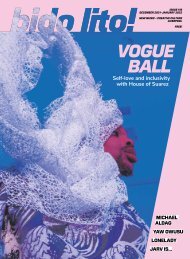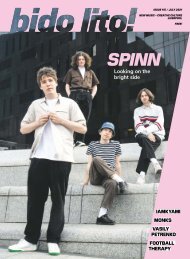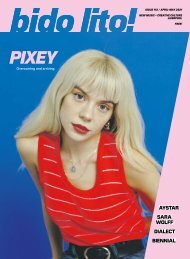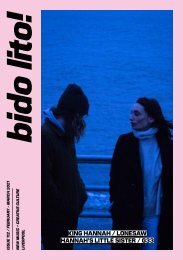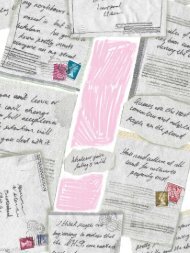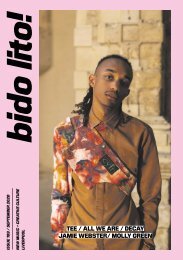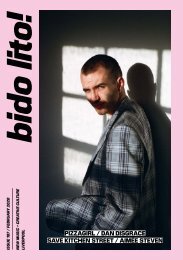Issue 105 / November 2019
November 2019 issue of Bido Lito! magazine. Featuring: THE MYSTERINES, NUTRIBE, TRUDY AND THE ROMANCE, KEITH HARING, BLACK LIPS, RICHARD DAWSON, LYDIAH, BALTIC WEEKENDER, IBIBIO SOUND MACHINE, RED RUM CLUB and much more.
November 2019 issue of Bido Lito! magazine. Featuring: THE MYSTERINES, NUTRIBE, TRUDY AND THE ROMANCE, KEITH HARING, BLACK LIPS, RICHARD DAWSON, LYDIAH, BALTIC WEEKENDER, IBIBIO SOUND MACHINE, RED RUM CLUB and much more.
Create successful ePaper yourself
Turn your PDF publications into a flip-book with our unique Google optimized e-Paper software.
COMING<br />
OUT<br />
THROUGH<br />
THE<br />
GIFT<br />
SHOP<br />
20<br />
As the hugely successful Keith Haring<br />
exhibition at Tate Liverpool moves into<br />
its final month, Jordan Ryder ponders<br />
whether there is a battle to sustain<br />
the artist’s campaigning sentiment<br />
in the face of its aesthetic appeal.<br />
I<br />
recently got my nose pierced. Yes, that<br />
darkening shape you can see on the horizon is<br />
my 30th birthday. Maybe I can blame that. Or<br />
I can blame my boyfriend for catching me at a<br />
weak moment and making a long held (but crucially<br />
hypothetical) desire happen. Regardless, the weight<br />
of my already sizeable head has increased marginally<br />
and I travel everywhere with a bottle of saline. Both<br />
my mother and a number of my male friends have<br />
remarked that they like it, it suits me, and “it makes me<br />
look more gay”. Brilliant. But, I suppose that was part of<br />
the point, when I think about it. This fairly unexceptional<br />
act of identity assertion happened aged 29. American<br />
artist KEITH HARING died in 1990, aged 31, of AIDSrelated<br />
complications.<br />
Over the course of his career he challenged the<br />
American government’s ignorance of the AIDS crisis,<br />
promoted safe sex and addressed the crack epidemic<br />
in 1980s New York, as well as highlighting the dangers<br />
of nuclear power. In conflating these two I do not seek<br />
to elevate my choice of metallic facial furniture to that of<br />
confrontational activist art, but rather highlight just how<br />
young Haring was to be one of the visual voices of socially<br />
conscious art during the Reagan era, and how an earlier<br />
knowledge and understanding of his work may have eased my<br />
own reconciliation with my homosexuality.<br />
Had I been exposed to his art beyond the T-shirts of<br />
my more fashion conscious friends, would I have felt more<br />
comfortable in myself? I’d like to believe this is the case. Equally,<br />
for any persons unsure of their gender, sexuality or even morality<br />
that visits, or has visited, the exhibition. Subtracted from this line of<br />
questioning, however, the exhibition is a huge success. Not just for<br />
the Tate, but for Liverpool in general.<br />
Returning to my point: if you expand this further, can art, in any<br />
format, provide a focal point for solidarity and identification in the<br />
same way music can, or is the message of an image or object more<br />
firmly rooted in the time and place of production? Does radical art<br />
only remain radical for so long, its didactic power only temporal and<br />
therefore limited?<br />
Essentially, can an exhibition of political art ever avoid the castration<br />
of that art’s political message? Indeed, can a work of art retain its political<br />
undertone without being part of a biographical retrospective?<br />
Take Haring’s Silence Equals Death (1989), for example. Building on<br />
the campaign of the same name by the AIDS Coalition to Unleash Power<br />
(ACT UP), Haring’s image recreates the infamous pink triangle on a stark<br />
black background. The reclaimed triangle, initially used as a marker of<br />
homosexuality in Nazi concentration camps, is plain and flat in the ACT UP<br />
poster, but in Haring’s work is overlain with figures representing the ‘see no<br />
evil, hear no evil, speak no evil’ maxim. The overall effect is striking in a very<br />
different way to the ACT UP poster. The tumble of human figures inevitably<br />
connote a pyramid of bodies, Haring certainly conflating the AIDS pandemic<br />
with the Holocaust, presenting both as a systematic eradication of a group<br />
maligned and ignored by the ruling class, the wilful ignorance and inaction of the<br />
Reagan administration set alongside the ideological antisemitism of the Nazis.<br />
As a 29-year-old gay man in <strong>2019</strong> this work of art represents not just a<br />
period in time and a particular aesthetic style, but a pivotal moment in the history<br />
of people like me, one that has shaped not only my perception of what it is to<br />
be gay, but also why it matters to not simply accept the superficial equality that<br />
is framed as progress. But I wonder whether that is the same for younger gay<br />
people, less politically aware gay people, or people who are not part of the LGBTQ+




